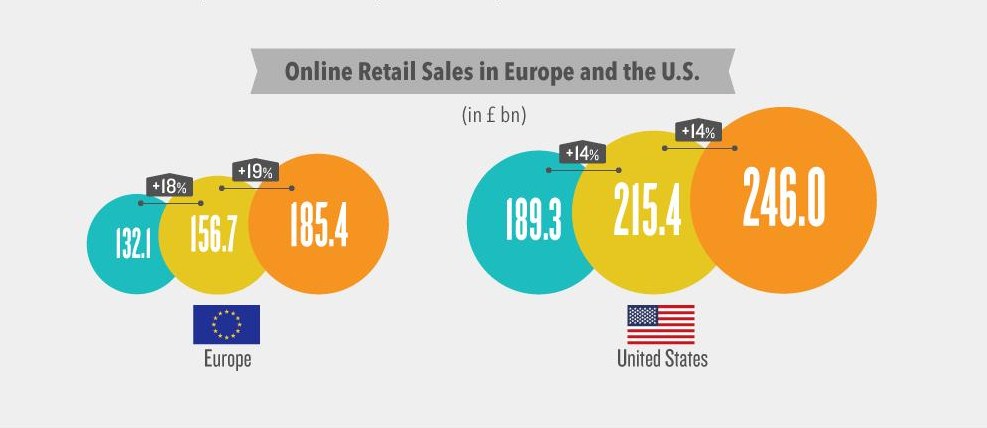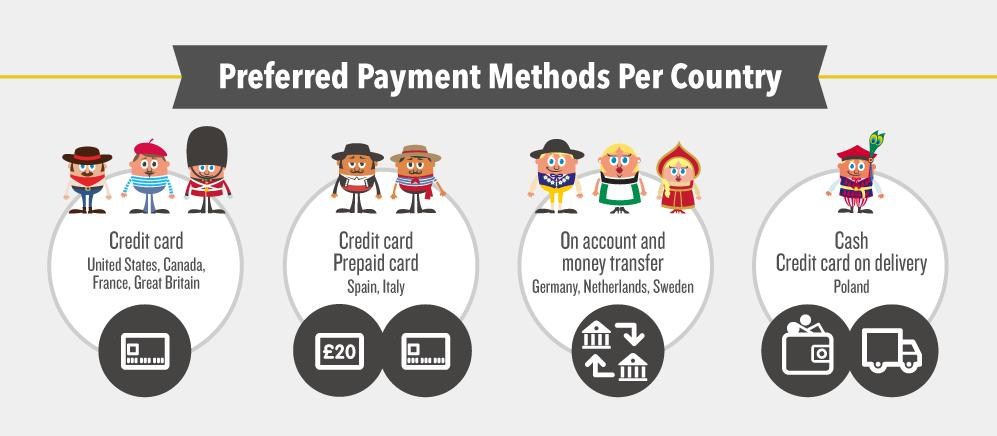Four Basic Steps To Get You Started
Cross-border expansion creates great business opportunities and in the world of eCommerce, the sky's the limit. A study conducted by Payvision reveals that by the end of 2018, 130 million cross-border eCommerce will amount to over $300 billion!
A large number of shoppers surf the web looking for the best product and best offer and in many cases find it cross-border in online stores abroad. Doesn’t that happen with us often when searching for customized gifts and while placing an order we realize it can’t be shipped in the country of our residence? That kind of surfing clan is growing increasingly and no wonder that requires online merchants to refocus their business on different geographical areas, offering a wider product range and an overall portfolio to serve a global market.
"eCommerce sales in Europe will increase by 18.4 % in 2015."
Although cross-border trade is developing at an increasing rate across the globe, online consumers from Europe are expected to make more online transactions in 2015 compared to 2014. In another research study conducted by RetailMeNot Inc. together with Center for Retail Research predicts that while online sales in Europe will increase by 18.4%, offline retail sales will decrease by 1.4%.
In fact, Europe is growing faster than the US and the UK in eCommerce. The infographic below shows the growth statistics and comparison for Europe and US.
Given such an upside potential to operate in a European market, there would be many online sellers considering this opportunity. Any why not? This is the time to make the most of it by enabling your online store to be visible and accessible in the European market.
While selling products through an online store is a simple, low cost of entering the European market, payment security, non-delivery or delayed delivery, fraud, lack of / varying dispute resolution mechanisms are still the major obstacles preventing consumers and businesses from engaging in eCommerce. Thanks to the combined impact of legislation, technology and tools, diligent traders and vigilant consumers, these obstacles are progressively receding.
For those who might be considering this move to Europe, here are few tips to start selling there:
1) Clear Information, Customized Design:
Your website should be optimally designed and easy to use. There is a legal obligation to have information such as your company’s name, as well as postal and email addresses permanently available to your consumers from Europe. Although not a brainer, most online sellers miss this point assuming that the transaction happens online and that doesn’t require seller information. However, this basic information can turn against you and affect your credibility as a seller.
It also helps to think through if you are going to target a particular country in Europe and that decision applies in terms of your website design. For e.g., In France, local consumers are accustomed to websites that are designed with a “more is more” policy, so a fancy interactive web design may be more suitable, while in Scandinavia, consumers prefer much more minimalist experience.
2) Offer Multiple Payment Options:
In Europe, it’s not all about credit cards. Payment preferences vary from country to country and it’s important for an online seller to provide multiple payment options to choose from. Although common payment forms such as credit card and PayPal may be used by many online shoppers, a large number of them still prefer money transfer and very local options such as Dankort (used as a hybrid of credit and debit card in Scandinavia) , GiroPay, Sofort Überweisung (in Germany), 4B ( in Spain). PayPal though is very famous in France.
3) Localize
As an outsider, it’s critical to gain the trust of European buyers. The wonderful thing about eCommerce is that building trust in business is methodological and acknowledged faster (also can be broken as soon as you make a small mistake and do not make up for it soon). We already talked about offering local payment options and care for payment preferences. Other two simple yet important ways of localizing your online business are web domain and language.
Consider using a local domain (.EU / .IT /. SE) name, displaying prices in local currency and also using local logistics for shipment.
Not all European countries speak and accept English very well. Thus, while selling in Europe, do not forget to let your customers know that, “I speak Da Lingo”! Having a native speaker can be of immense value because the more you online store contains translated content, better are the chances of you connecting with potential consumers. While translation is important, you want to be very careful about ensuring that you make no mistakes by using a literal translation. Google translator can come in handy and is easy, but if there are any linguistic mistakes, you might end up looking untrustworthy.
Heard about the episode of John F. Kennedy’s speech at Berlin Wall ceremony in 1963? The Germans chuckled with embarrassment when he uttered the words ‘Ich bin in Berliner‘. The literal translation of that being “I am a jelly-filled doughnut!”.
Avoid the embarrassment; hire a native speaker to handle marketing activities of your online store dedicated to the European market.
4) Know the law of the land
You may like to consider Europe as one, consolidated, consistent continent. But, that’s obviously not the case. Although Europe is trying to standardize laws and that is apparent with the result that cross-border eCommerce is boosting in the European region, each country still has their own eCommerce laws and regulations. This may pose some challenges to expand your online sales in European countries. Research the local laws before establishing your presence and an even better idea is to partner with a local attorney who can guide you through this process, ensuring you break no laws.
For example, in Germany, there’s something called “Abmahnung“, a written warning you could receive when your eCommerce store doesn’t follow the German law. Lawyers are allowed to invoice their costs (€800-€1.500) of writing this warning and when you choose not to pay, you risk a lawsuit. German laws are complicated and specific. Not using a right word at the purchase check-out might land you in trouble.
Also, note that one of the most recent European eCommerce laws is that add-to-cart buttons must contain a text that shows visitors they have to pay if they continue with the transaction.
Summary:
When in Rome, Do As The Romans Do.
Here is an infographic (in 3 different languages) which captures important statistics you should know about eCommerce in Europe.
English:
French:
infographie-e-commerce-chiffres-cles-2014-et-perspectives-2015





